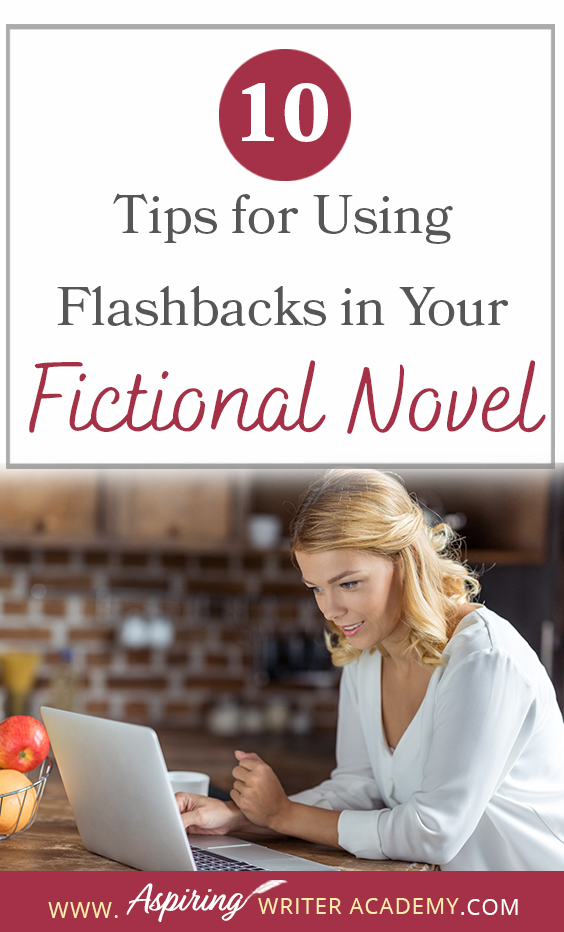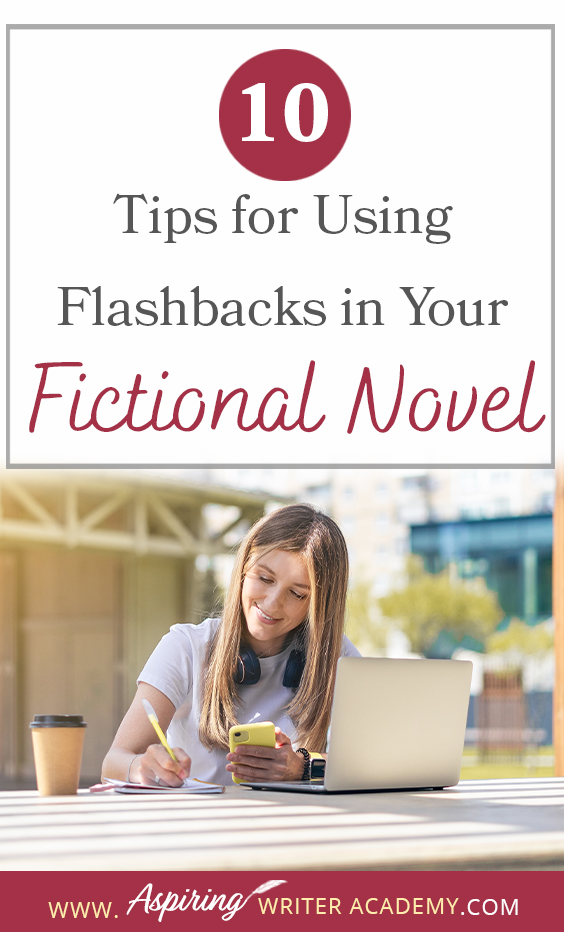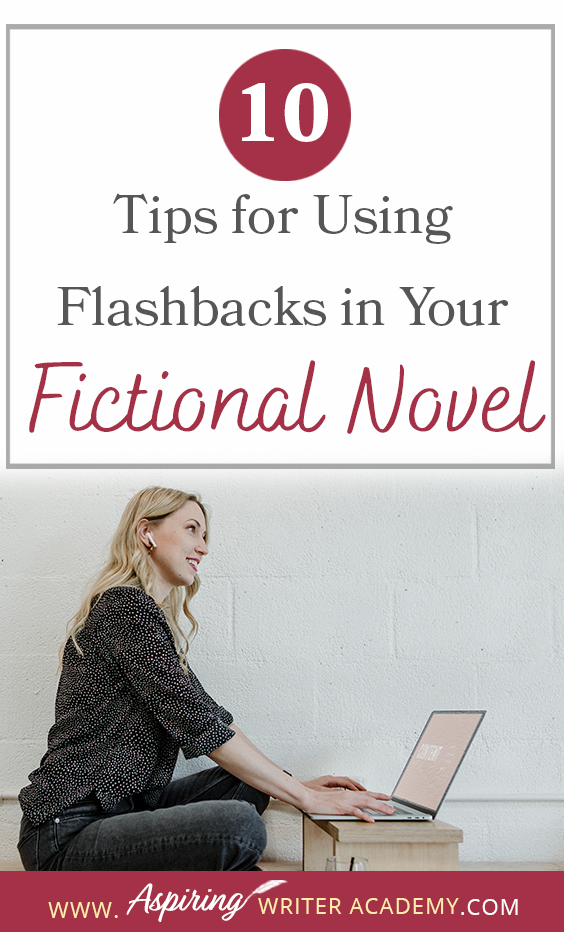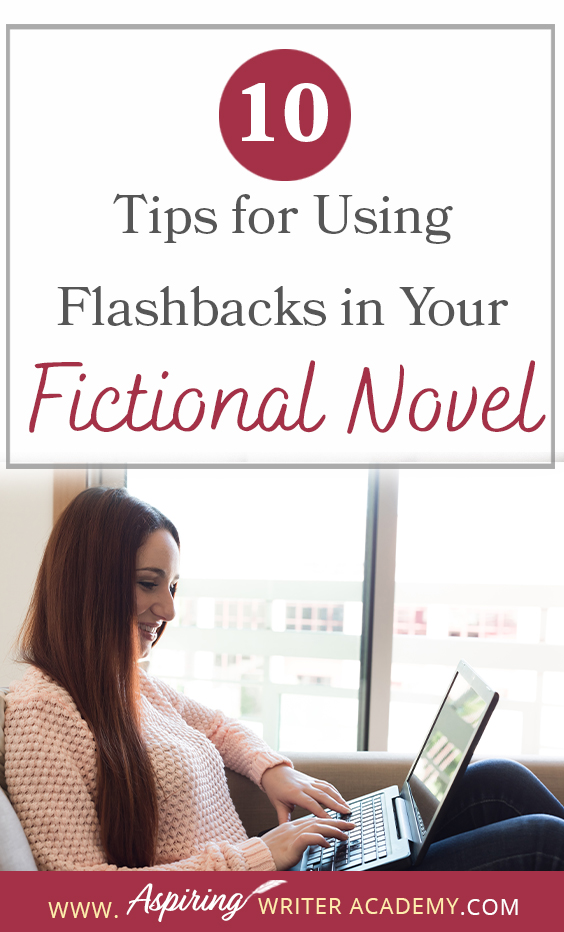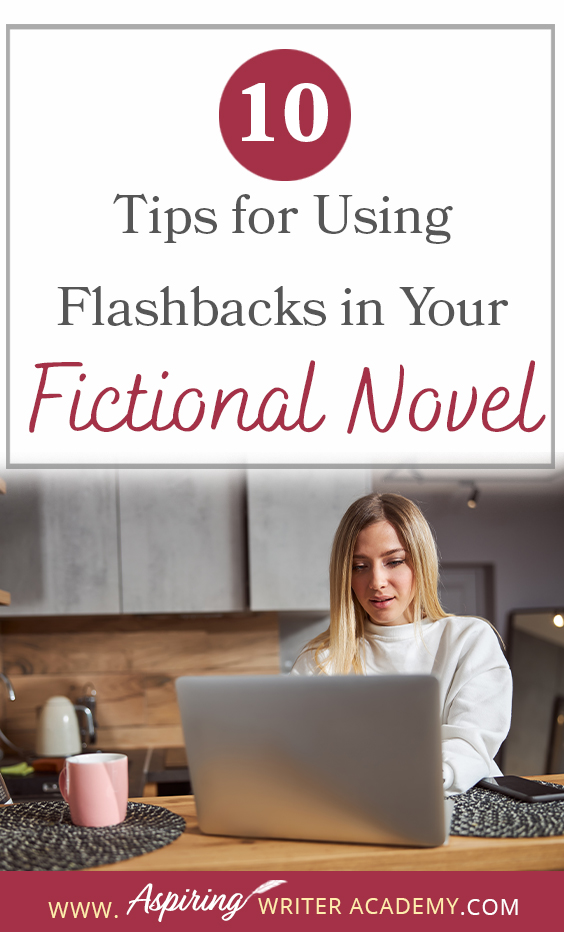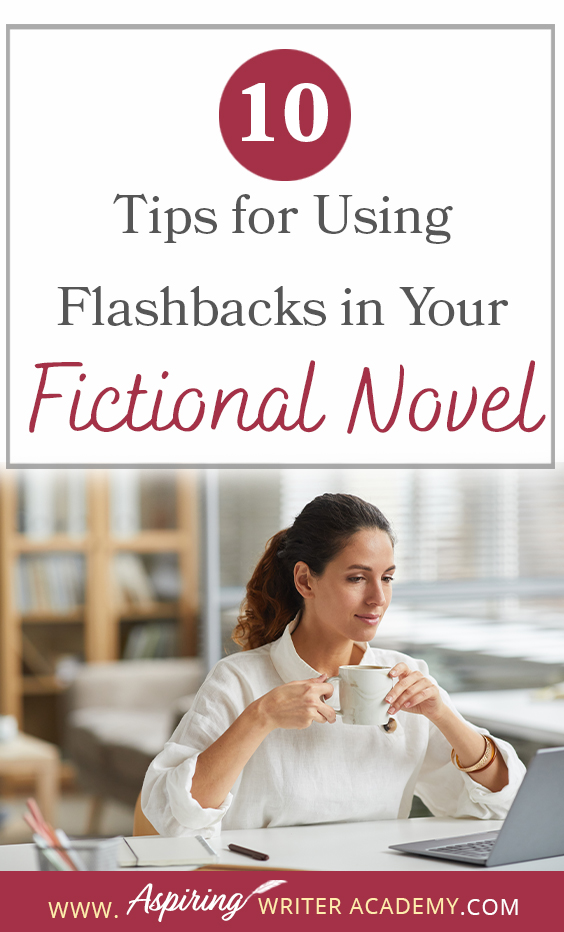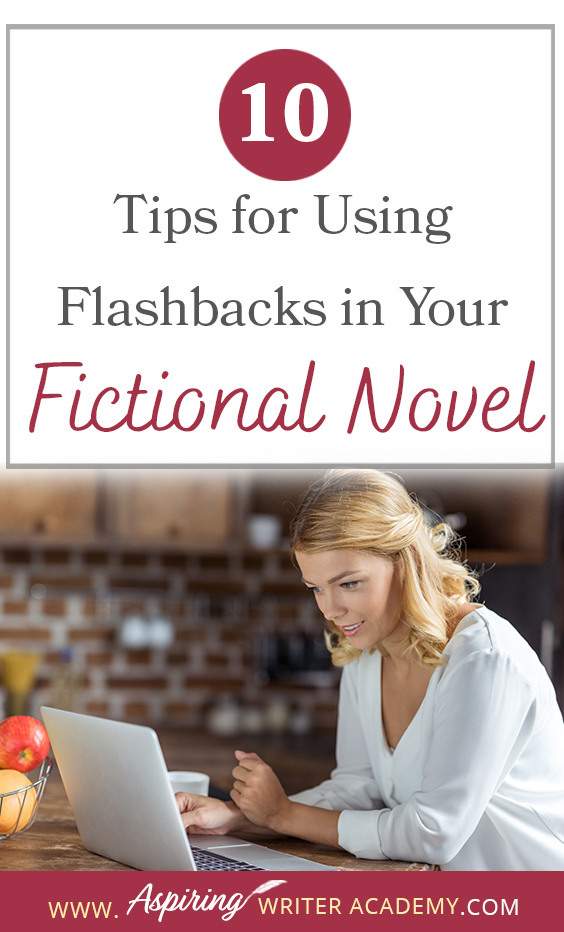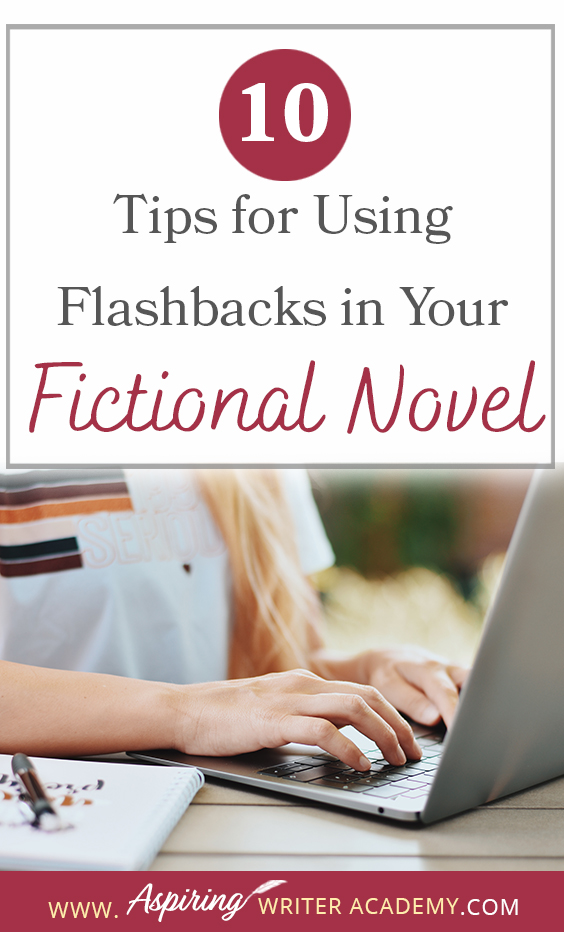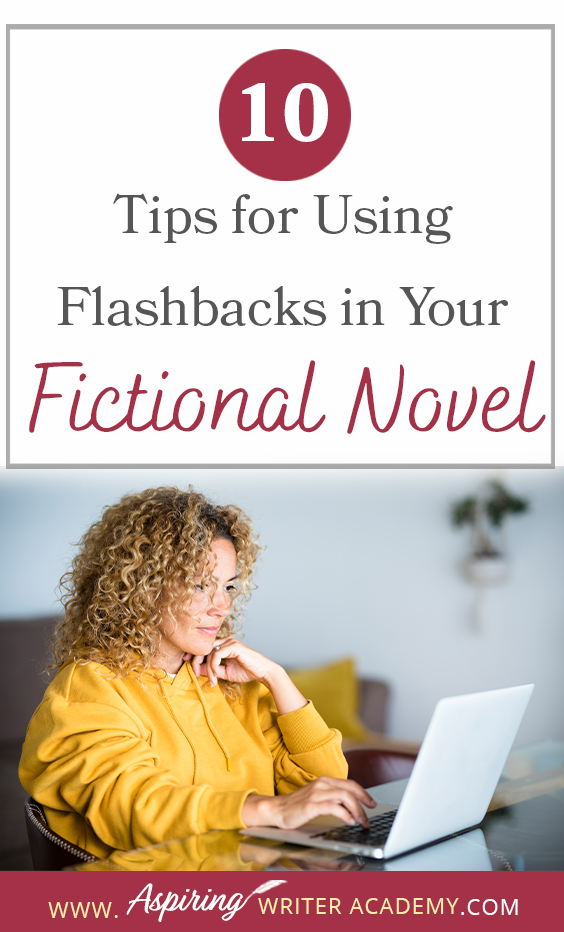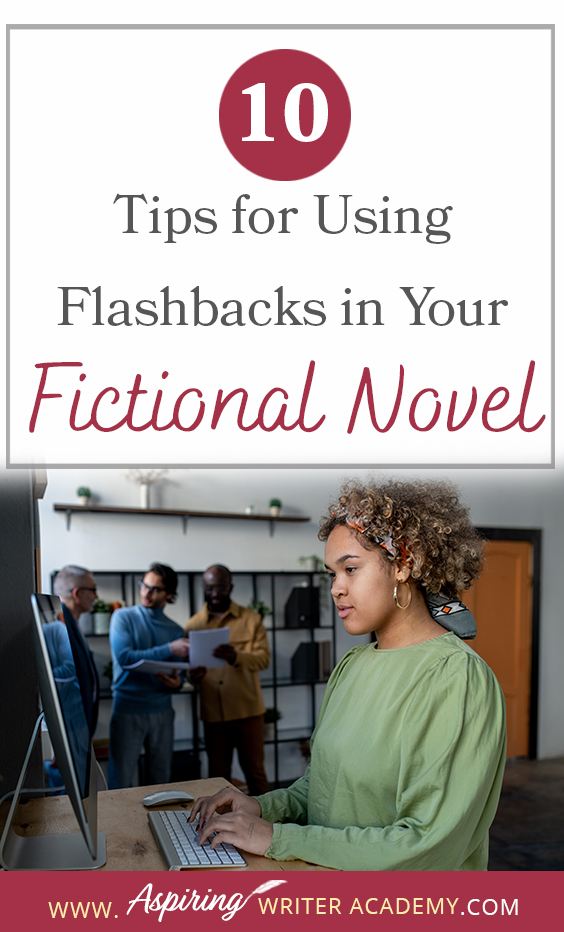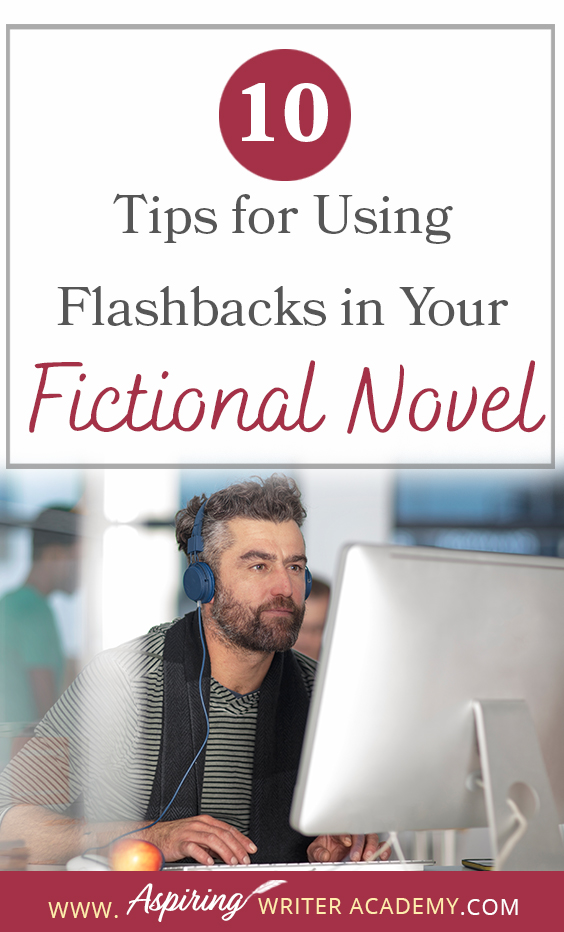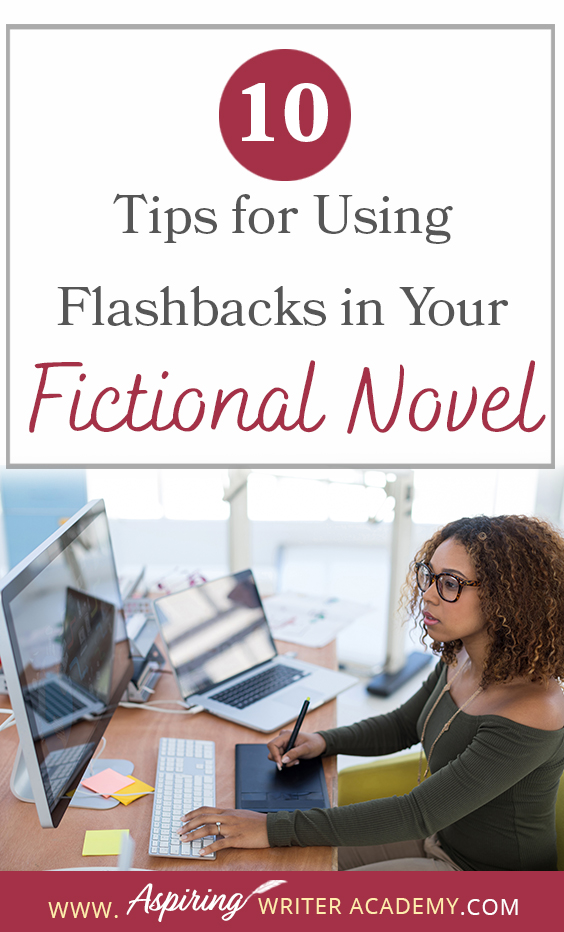10 Tips for Using Flashbacks in Your Fictional Novel
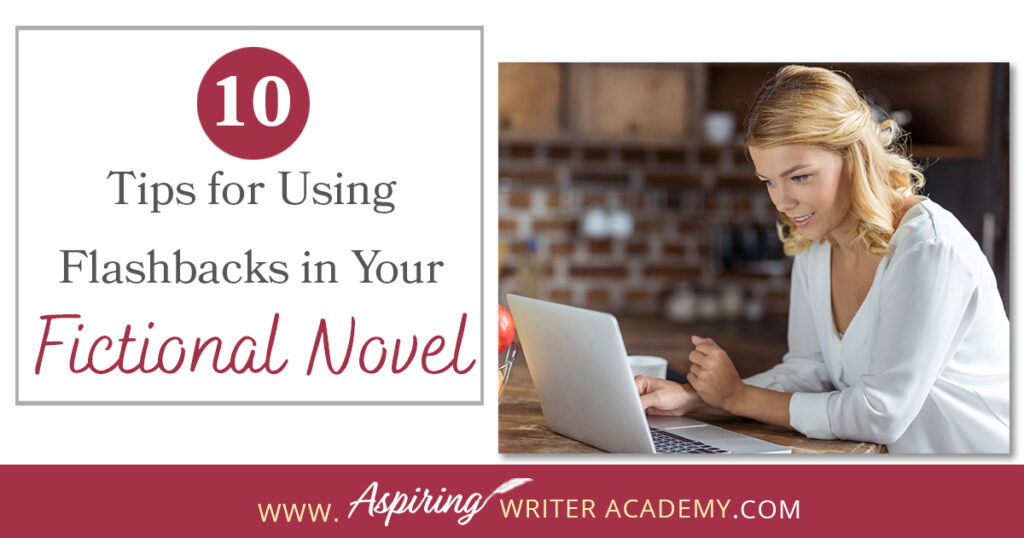
A flashback in a fictional novel is a scene that happened in the past to show characterization, motivation, or explain a facet of the present story. But how do you transition in and out of a flashback scene? How many are too many? Are there rules to writing flashbacks?
In 10 Tips for Using Flashbacks in Your Fictional Novel, we discuss how to write clear, concise, plot-driven flashback scenes that will strengthen the story and hook your reader.
1) When to use a Flashback?
You may want to use a flashback scene in your novel (where a character recalls a specific moment in his/her past) to reveal the character’s past trauma (backstory wound) or show the reason (motivation) your character reacts to life the way he does. Flashbacks can also give the reader a glimpse into how specific relationships in the character’s life were formed or reveal eye-opening information previously unknown to the reader.
However, there are specific reasons for using a flashback scene.
- Some writing instructors say avoid flashbacks in your novel since they take the reader out of the present story and slow momentum. Others believe flashbacks can deepen and intensify a novel but should only be used sparingly.
- A flashback is a SCENE allowing the reader to be shown, not told, what happened in the past. It is not dialogue between characters talking about the past. It is a vivid recollection in the point of view character’s mind played live for the reader to experience in all its glorious detail and engages the 5 senses.
- The flashback scene must directly impact the present story, or it should not be included in your novel. A flashback should serve a purpose other than just showing how a character grew up or why she likes apples. It must advance the plot. Whatever you show in the flashback scene should be important enough that it continues to impact the character now, as he struggles to achieve his goal in the current story.
- Avoid using flashbacks in the opening scenes of your novel. It’s best to get into the heart of the present story and establish the characters involved before slowing down for a glimpse into the past. Then perhaps a flashback is warranted after the opening scenes to help set up the story or maybe a flashback would be better right before the character faces a fear similar to one he faced in the past. Where would this flashback have the most impact in your fictional novel?
- For those of you who are familiar with the components of Scene & Sequel for Story Structure, flashbacks often occur during Sequels where the character is pondering what just happened in the previous scene and is trying to decide his next course of action. A flashback may help this character make a decision.
2) How to Transition in and out of a Flashback
One way is to start the flashback at the beginning of a new chapter or scene with the date (month /year) above the first paragraph in italics. Return to the present story after the flashback is over by inserting the italicized date of the present story above the start of the next chapter or scene and continue forward.
A second way to start a flashback is to place the character in a situation that acts as a trigger for the character to reflect on the past, and then use a trigger phrase.
Example:
The character may return to his childhood home after many years searching for a clue to the whereabouts of his missing sister. His eyes might lock on a familiar object in her room, which startles him. The last time he’d seen that (object) was…
The character may slip into deep thought and use a trigger phrase to transport the reader to the past. You may choose to use the ellipses (…) but it is not necessary.
Trigger phrases:
- It had been fifteen years since he’d seen the clown figurine on her nightstand…
- The day his sister received the clown figurine from their grandma had been a day to remember.
- At the sight of the clown figurine his thoughts were instantly transported back to the day Grandma handed out presents at Christmas.
- His sister had been eight years old when she received that horrid clown figurine…
- He could remember when his sister had first received that clown figurine.
After the flashback you can transition back to the present using a trigger from the real-time story world to ‘snap the character out of the past.’ A car horn honking, or something that the reader would recognize from the current story setting.
Example:
The shrill musical ring of his cell phone drew him back to the present.
The creak of the old wooden front door opening drew his attention away from childhood memories and his partner shouted, “Find anything?”
3) Change the Verb Tense
When you transition into the flashback it is important to use past tense verbs to show the reader that this scene happened in the past.
Examples:
He had said…
The important thing to her had been—
She hadn’t wanted him to know—
I had only been eight years old when they’d moved into the neighborhood. I can still remember when they caught him trespassing through their backyard.
Once you have established the scene happened in the past, it is fine to move back to present tense verbs again to make it read easier without using the word ‘had’ too many times. (He had said this, He had done that, He—had had had.) Just go right into ‘He said’ ‘He ran into the room.’ Show the past scene unfold as if it is happening in present time.
To transition back to the current story, you will once again use a couple past tense verbs to remind the reader this scene is from the past and now you are returning to the present. You might even use another trigger phrase.
Example:
But that had been ten years ago. Things were different now.
Or– But times had changed and so had he. He wasn’t that little boy anymore.
4) Use a Trigger to Help with the Transition
It is important to use clear transitions in and out of the past to avoid confusing your reader. Confusion pulls the reader out of the story and leads to frustration if the reader cannot figure out what is going on.
We already discussed trigger phrases and even objects in the setting that can act as a trigger to signal a transition. But let’s go deeper. What else can trigger a character to recall the past?
- Hearing someone use a certain phrase (perhaps said to the character by someone else in the past?)
- Think about the 5 senses: Sight, Smell, Hear, Taste, Feel/Touch. When we smell certain things, taste certain things, don’t they bring back memories? Or remind us of other places we’ve been?
- Consider aspects of the setting: a familiar sunrise popping up over the mountains, the chill wind of the ocean breeze flapping her hair around like the wings of a duck, the shade of purple at sunset which reminded him of his grandpa’s purple grapes hanging in the orchard.
- The catalyst or trigger for the flashback can repeat at the end of the flashback to pull the character back to the present and act as “bookends” or a “frame.” Make the trigger for this kind of flashback relate to the flashback and what it represents.
Example:
If your character is hit by hail and dives into a flashback where hail had once led him to take shelter with a girl he wished he’d had the courage to marry, another piece of hail in the present can hit him on the nose to transition out of the flashback and punctuate his regret— remind him how his life had turned out: cold and alone and pelted by string of strategic stinging blows.
5) What is the Proper Length of a Flashback?
An entire story can be a Flashback if the author uses scenes from the present time period at the beginning and end to “frame” the story.
A flashback can also be a whole chapter. But make sure it serves a meaningful purpose and drives the main storyline forward.
Most times, your Flashback will be a single scene. Focus on one specific moment. And keep it as brief as possible. Get in and get out as fast as you can. Make your point and return to the main storyline. Avoid going off into unnecessary detail.
Sometimes Flashbacks take up only one paragraph. Keep the content concise, interesting, and relevant to keep the reader engaged.
6) Make Sure the Flashback Advances the Plot
Every scene in your fictional novel should reveal aspects about your character and advance the main story. Your Flashback scenes should do the same. The Flashback scene should reveal information that is important to the current story. It should serve a purpose, a reason for being.
How does this Flashback relate to the main character taking steps to overcome opposition and achieve his story goal?
What does your character realize about his current circumstances after recalling a scene from his past? Or what does he realize about another character? What insight?
In a mystery novel, a recollection of the past may help an amateur sleuth solve a murder. What did he or she see or hear in the past that they didn’t realize was a clue until now?
7) Show, don’t Tell
Make sure that you are not simply just telling the reader what happened in the past. Show it! After using your transitional trigger phrases, slip from past tense verbs to present tense and write the scene as if it is unfolding right in front of the reader’s eyes. Let them see the action, hear what the characters are saying in true dialogue, and smell the smells, feel the textures, the temperature of that past setting in detail.
Bring the reader into the past to relive the moment along with your point-of-view character. This will keep the passage active and alive, filled with the tension of the moment and possibly even rev up the tension in the main plot as well. Learning an important secret from the past that affects the main storyline keeps the reader engaged and wondering what will happen next.
8) Make the Past Reflect the Past
We are talking about sensory details here. If you have a Flashback scene set in the past, do not forget to include the details of that time era to paint a colorful picture for the reader.
- How was life different in that time period? What were the customs?
- How can you contrast specific details from the past with the present?
- What did people eat, drink, or wear in the time of your character’s Flashback scene? What were the hair styles? Fashionable trends?
- What was going on in the world and what were they reading in the newspapers?
- What slang or common phrases were spoken?
- What kind of music did people listen to?
- How has technology advanced?
- How has the character’s circumstances changed?
Now, it is important to remember that these details should only be included if it serves to enhance the point that you are making by including the Flashback in the story. The reader does not need a long cultural history detailing the time period of the Flashback.
But a few key details thrown in to flavor the passage will ground the reader in the past and connect them to the characters involved. The Flashback will feel more authentic.
Also remember—do NOT include items in your Flashback from the past that were not invented yet! Do your research.
9) Stay in One Point-of-View
Today’s reader (and the various publishing houses) do not want a novel with a lot of ‘head-hopping.’ It is advised that the author stick to one character’s (POV) point-of-view per scene. If you want to change the POV character to someone else, wait until the next scene. This avoids confusion and allows the reader to connect on a deeper level with the POV character, seeing and hearing and experiencing everything the way they do.
A Flashback scene should also only have one POV, the character who is recalling the Flashback. The scene in the past is viewed from this character’s memories or perception, which may be different than some of the other characters in the story. They may have their own version of what happened long ago.
10) Limit the Number of Flashbacks in Your Story
The reader is most invested in the main storyline, not the past. Use Flashbacks sparingly and only with good reason.
Most definitely try to keep Flashbacks out of the beginning chapters of your fictional novel. A common mistake many beginning writers make is to bog down the beginning of their story with too many Flashback scenes thinking they need to tell the reader everything that happened in the past to understand the story. That is not true. Start with action in the present story and reveal bits of the past in tiny pieces through dialogue and the character’s internal thoughts as you go. Most times Flashbacks are not even needed.
Too many Flashbacks slow the pacing and bore the reader. Only use a Flashback scene if there is no other way to convey the information that you want to reveal.
However, if set up and written properly, Flashback scenes can add depth to your characters, spark to your story, and reveal key information crucial to the main storyline.
We hope you have found 10 Tips for Using Flashbacks in Your Fictional Novel helpful and that you can use some of the included tips to strengthen your writing.
If you have any questions or would like to leave a comment below, we would love to hear from you!
If you like more help developing your story, you may wish to download our Free Brainstorming Your Story Idea Worksheet
Do you find it difficult to create compelling antagonists and villains for your stories? Do your villains feel cartoonish and unbelievable? Do they lack motivation or a specific game plan? Discover the secrets to crafting villains that will stick with your readers long after they finish your story, with our How to Create Antagonists & Villains Workbook.
This 32-page instructional workbook is packed with valuable fill-in-the-blank templates and practical advice to help you create memorable and effective antagonists and villains. Whether you're a seasoned writer or just starting out, this workbook will take your writing to the next level.
Our Goal for Aspiring Writer Academy is to help people learn how to write quality fiction, teach them to publish and promote their work, and to give them the necessary tools to pursue a writing career.

ENTER YOUR EMAIL BELOW
TO GET YOUR FREE
"Brainstorming Your Story Idea Worksheet"
7 easy fill-in-the-blank pages,
+ 2 bonus pages filled with additional story examples.
A valuable tool to develop story plots again and again.
Other Blog Posts You May Like
How to Use Framing Techniques in Your Fictional Novel
How to Write a Novel with the W-Plot Template
How to Use Themes in Your Fictional Story
Fiction Writing: What is a Pinch Point?
7 Tips for Writing a Story Synopsis
Fiction Writing: What is the ‘Black Moment?’
Fiction Writing: What is the ‘Man in the Mirror Moment?’
Fiction Writing: What is a Plot Hole?
How to Write Act III and Finish Your Fictional Story in 5 Steps
Structuring Act II (Part 2) for Maximum Impact: How to Keep Readers Engaged
Structuring Act II (Part 1) for Maximum Impact: How to Keep Readers Engaged
How to Use Setting to Intensify Your Fictional Scenes
How to Manipulate Pacing to Increase the Intensity of Your Scenes in a Fictional Novel
How to Brainstorm a New Novel Using Goal, Motivation, and Conflict
Fiction Writing: How to Plot a Story where the Antagonist is an ‘Invisible Foe’
Fiction Writing: Create a Storyboard to Map Out Your Scenes
3 Ways to Avoid Writing ‘Episodic’ Scenes in Fiction
How to Write Act I: Opening Scenes for Your Fictional Story
Brainstorming Fiction: What to Do When Your Story Gets “Stuck”
How to Plot Your Fictional Novel (with Free Template Included)
5 Questions to Create Believable Villains
Why Your Characters Need Story-Worthy Goals
How to Captivate Your Readers with Scene-Ending Hooks
Scene & Sequel: The Secret to Plotting an Epic Novel (Part 2)

is a multi-published author, speaker, and writing coach. She writes sweet contemporary, inspirational, and historical romance and loves teaching aspiring writers how to write quality fiction. Read her inspiring story of how she published her first book and launched a successful writing career.

